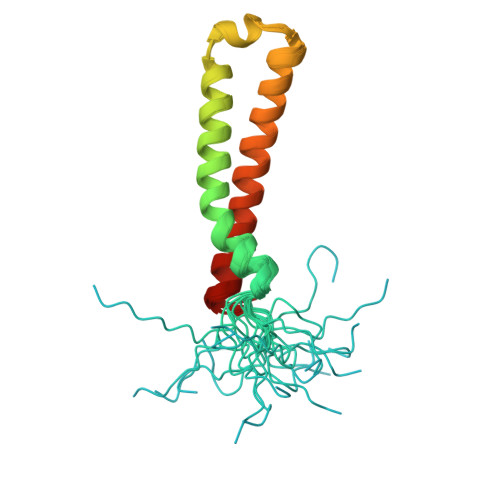The C-terminal domain of the Uup protein is a DNA-binding coiled coil motif.
Carlier, L., Haase, A.S., Burgos Zepeda, M.Y., Dassa, E., Lequin, O.(2012) J Struct Biol 180: 577-584
- PubMed: 22995754
- DOI: https://doi.org/10.1016/j.jsb.2012.09.005
- Primary Citation of Related Structures:
2LW1 - PubMed Abstract:
The bacterial Uup protein belongs to the REG subfamily of soluble ATP-binding cassette (ABC) ATPases, and is implicated in precise excision of transposons. In Escherichia coli, the uup gene encodes a 72 kDa polypeptide that comprises two ABC domains, separated by a linker region, and a 12kDa C-terminal domain (CTD). Uup binds double-stranded DNA with no sequence specificity, and we previously demonstrated that the CTD domain is a crucial region that participates in DNA-binding activity. We report herein the NMR structure of Uup CTD, consisting of an intramolecular antiparallel two-stranded coiled coil motif. Structural comparison with analogous coiled coil domains reveals that Uup CTD contains an atypical 3(10)-helix in the α-hairpin region that contributes to the hydrophobic core. Using NMR titration experiments, we identified residues of the CTD domain involved in the binding to double-stranded DNA. These residues are located on two opposite surfaces at the base of the coiled coil, formed by the N- and C-terminal extremities, where a strictly conserved proline residue induces an overwinding of the coiled coil. Finally, preliminary analysis of NMR spectra recorded on distinct Uup constructs precludes a fully flexible positioning of the CTD domain in full-length Uup. These structural data are the first reported for a non-ATPase domain within ABC REG subfamily.
Organizational Affiliation:
UPMC Université Paris 06, Laboratoire des BioMolécules UMR 7203, 4 place Jussieu, 75005 Paris, France. ludovic.carlier@upmc.fr
















